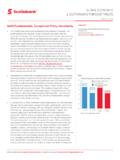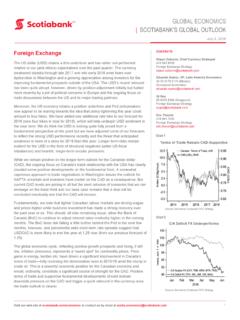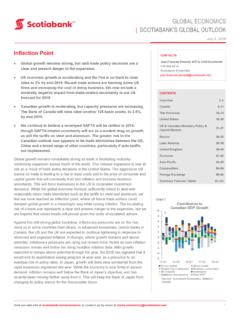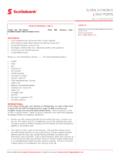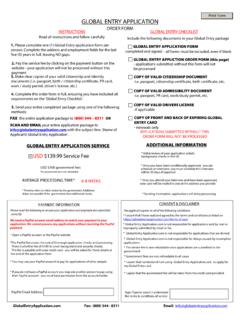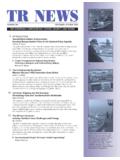Transcription of GLOBAL ECONOMICS SCOTIABANK’S GLOBAL …
1 1 April 12, 2018 GLOBAL ECONOMICS | SCOTIABANK S GLOBAL OUTLOOK Visit our web site at or contact us by email at Rates and Uncertainty on the Rise GLOBAL momentum remains strong, but US trade policy is generating much uncertainty. Trade tensions between the United States and China are the dominant risk to the economic and financial market outlook. NAFTA negotiations, on the other hand, seem to be on a much improved track. Despite rising uncertainty, economic conditions in the US, UK and Canada continue to point to the need for higher interest rates. All three countries are expected to hike interest rates two more times this year. The strength of GLOBAL demand is leading to a significant increase in most commodity prices relative to last year.
2 This is benefitting commodity exporting nations, such as those in the Pacific Alliance, where growth is expected to be much stronger than in 2017 in spite of political uncertainty in some countries. The Canadian dollar is expected to strengthen through the year, with the potential for an even more aggressive appreciation if the NAFTA negotiations are concluded. We are on the cusp of a long-feared escalation in trade tensions, the dominant risk of the Trump presidency. Though we have flagged this risk since his election, our hope was that the costs of a trade conflict would be high enough to ensure a more rational course of action. As we finalized this forecast, it has become clear that the Trump administration is placing greater weight on antagonism than on the economic costs to the United States of retaliatory trade policies.
3 What is less clear at this time is how serious the threat of a trade war is: the Trump administration has proposed tariffs on USD 150 bn worth of Chinese imports, with the Chinese promising to respond in kind. Whether this is a bluff, as most of President Trump s aggressive statements on various issues have been so far, remains to be seen. For the moment, increasing trade tensions are leading to heightened financial volatility, affecting virtually every asset class. There is no question, however, that an escalation in tit-for-tat trade measures would have very significant implications for the United States and China, and that these consequences would spill over into other economies, notably those that are most closely integrated with these countries.
4 This threat looms large over economic outcomes, and on central bank actions in North America. The NAFTA negotiations stand in some contrast to the escalation in trade protectionism undertaken by the US with the rest of the world. It is now clear the US wants to remain in NAFTA, as the Trump Administration appears willing to compromise on key demands in a rush to secure a revised NAFTA for the fall US midterm elections. Since NAFTA-related uncertainty has been a drag on Canadian and Mexican activity, an early deal has the potential to lift many of the negative consequences associated with the trade negotiations. Setting aside trade risks, all indications suggest that the GLOBAL expansion remains solid, largely synchronized, and resilient.
5 Broadly-based growth remains evident in Chart 1 CONTACTS Jean-Fran ois Perrault, SVP & Chief Economist Scotiabank ECONOMICS CONTENTS Overview 1 3 Canada 4 10 The Provinces 11 13 United States 14 19 US & Canadian Monetary Policy & Capital Markets 20 29 Mexico 30 31 Latin America 32 40 United Kingdom 41 42 Eurozone 43 44 Asia-Pacific 45 51 Commodities 52 54 Foreign Exchange 55 56 Summary Forecast Tables A1 A3 012345612141618 World Trade Volumey/y % change, 3 MMAS ources:Scotiabank ECONOMICS , Netherlands Bureau for Economic Policy April 12, 2018 GLOBAL ECONOMICS | SCOTIABANK S GLOBAL OUTLOOK Visit our web site at or contact us by email at almost all parts of the globe, as consumption and business activity generally remain robust, though pockets of weakness are appearing.
6 As a testament to the strength and mutually-reinforcing nature of the GLOBAL expansion, GLOBAL trade volumes are rising to levels not seen since mid-2011 despite concerns about trade protectionism (chart 1). GLOBAL momentum and strong growth in GLOBAL industrial production have led to a significant rise in commodity prices relative to last year. This strength is expected to last, even though trade-related increases in risk aversion have led to some softness in prices in March. Gold prices are perhaps the best demonstration of the impact of risk aversion, as prices of bullion have departed from the usually stable relationship with real interest rates. The impact of strong GLOBAL demand is most evident in the energy sector, with WTI expected to average US$65 per barrel, up nearly US$15 per barrel from 2017 levels, but metals and materials have also strongly benefitted from strong demand.
7 Zinc and nickel, for example, are expected to trade roughly 25% higher than last year s levels. In Europe and the UK, momentum remains solid in spite of a softening in indicators early this year. In Europe, this pause follows a torrid pace set last year, while in the UK it reflects temporary factors, such as an outage in a major pipeline. Japanese growth should slow from last year s rapid pace, by Japanese standards, and remain above its potential. Among these three central banks, we forecast only the Bank of England to be active in 2018, with 2 additional hikes this year. Inflationary pressures remain too muted for the ECB and Bank of Japan to raise rates in the foreseeable future. In China, growth will slow given the reduced amount of policy stimulus being provided by authorities, but remain around As China continues on its path of structural reform and economic liberalization, brewing trade tensions with the US pose a significant risk to the outlook.
8 We will need to adjust our forecast if these risks materialize. In the US, growth remains robust, turbocharged by fiscal stimulus that is adding, on average, about half a percentage point to growth this year and next. Confidence remains high, and fundamentals remain strongly supportive of continued strength, even if consumption is off to a slow start in 2018. The industrial and service sectors are both expanding at paces not seen in the last decade. Though investment has been strong, capacity utilization rates continue to climb, which indicates a need for greater investment. Capital expenditures will also receive a boost from elements in the recently passed tax package. The economy should trip into excess demand this year owing in large measure to fiscal policy, leading to greater inflationary pressure, which in turn would necessitate monetary tightening.
9 Our model-based approach suggests US policy rates need to rise by 125 bps through end-2019, but we currently forecast that the Fed will raise rates only two more times this year, and twice more next year. A number of considerations motivate this deviation from our model, ranging from the recent rise in Libor-OIS spreads whose effect is difficult to capture, to the uncertainty associated with US trade policy. The path for US interest rates is highly conditional on the evolution of trade tensions between the US and China. In Canada, we continue to look for slowing, but still above-potential, growth. Informed by our model, we project real GDP growth to keep coming down from in 2017 to in 2018 and in 2019. These growth projections reflect two cross-cutting and largely offsetting sets of influences: Canadian economic activity receives positive spillovers from US fiscal stimulus and rising oil prices, but this is counter-balanced by our presumption that investment is dampened by uncertainty stemming from the still-pending status of NAFTA, escalating US-China trade rhetoric, and adjustment to the recent additional tightening of mortgage lending standards in Canada.
10 Remove these caveats and our macro model implies growth rates about 30 bps higher in 2018 and 10 bps higher in 2019. Table 1 Consumer PricesGlobal Real GDP2000 16201620172018f2019f World (PPP) United United South : Scotiabank ECONOMICS , Statistics Canada, BEA, BLS, IMF, Bloomberg. (annual % change)3 April 12, 2018 GLOBAL ECONOMICS | SCOTIABANK S GLOBAL OUTLOOK Visit our web site at or contact us by email at The Bank of Canada (BoC) is expected to raise rates further. Although Canadian growth is decelerating, it is set to remain above the economy s potential. Capacity pressures are undeniable and will increase: the share of industries operating with capacity utilization rates above their long-run average is at its highest level in 12 years (chart 2), order backlogs are rising, the unemployment rate is at a 43-year low, and there are increasingly widespread labour shortages.
